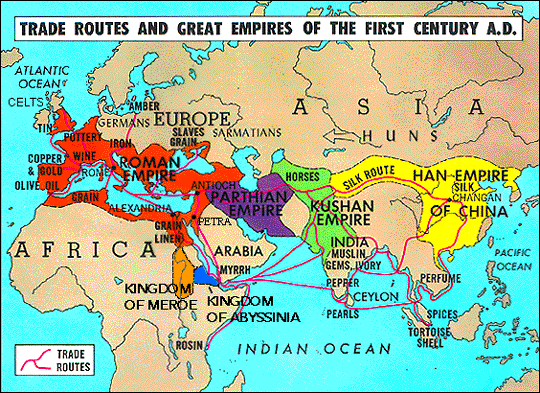
AS
By Land
There have been regular trade routes across land between India and China since early times that often crossed Upper Burma. This is known from Chinese chronicles (c. 2nd century CE) that Chinese merchants had reached the whole of North India and more; a Chinese writer, Kia Tan, also made reference to a land-route between Vietnam and India, while Burmese chronicles referred to a more direct route between Eastern India and Burma. At many points along the routes, the Indians could travel further down to Lower Burma and other parts of mainland Southeast Asia. However, the Indians could not get to maritime Southeast Asia solely by land.


By Sea
There were many flourishing Indian ports, from Broach on the west to Tamralipti on the east and many in between. We know detailed accounts of voyages from these ports, including those to Southeast Asia, from the Periplus of Erythaean Sea and Ptolemy. According to the latter, vessels bound for ports in the Malay Peninsula and beyond made a direct voyage across the high seas to the Malay Peninsula, where they could pass through the Malacca Straits to the reach both mainland and maritime Southeast Asia. They could also have travelled by sea to Kedah or Takua Pa where ancient archaelogical remains suggesting Indian influence have been found.

Partly by Sea and Partly by Land
In the case of vessels headed for mainland Southeast Asia, the route suggested by the Ptolemy would mean the vessels navigated the length of the Peninsula twice: once on the way down from India to the Malacca Straits, and the other time on the way back up. In such cases, many travellers got down at Kedah or the Isthmus of Kra in present day Thailand and travelled on land to other parts of mainland Southeast Asia. For those that needed to get to the opposite coast of the Bay of Bandon, the Isthmus of Kra was ideal as it was located at the narrowest part of the Malay Peninsula so crossing over was faster. This is proved by archaelogical remains around the area, as well as a persistant local tradition favouring the early migration of Indians along this route; colonies of Indian descent still survive on coast of the Bay of Bandon and trace the arrival of their ancestors by this route.
The Route from India to Southeast Asia
The routes taken by the various Indian agents to arrive in, and spread their influence to, Southeast Asia can be broadly classified into three categories. Although many of the routes described were orignially trade routes, their established existence would have allowed the other agents to travel along them as well. The limitations of each route for the different empires in Southeast Asia are usually concerned with their geographical location and hydrosphere.
It is likely that the Indians came to Sumatra by sea. This can be deduced from disproving the other two options as well as proving this option.
They could not have come solely by land as Sumatra is located in maritime Southeast Asia and is not connected to India by any piece of land. Meanwhile, it is also unlikely that they came partly by sea and partly by land, as this option is more suited to empires situated near the Malay Peninsula on mainland Southeast Asia. This is because upon alighting along the Malay Peninsula, there would be no land connecting them to Sumatra.
It is likely that the Indians came to Sumatra by sea. In addition to the Indian narratives that detail this route, it was also along the lucrative Sino-Indic trade route. As seen from the map below, many trade routes from India passed through the Malacca Straits and Sunda Straits, and Sumatra has convenient access to both these straits. As such, it can be not just implied but confirmed that there were definitely Indians that came to Sumatra by sea. It is also worth noting that Indianization of Southeast Asia, including the rise of Srivijaya, occured when India-Southeast Asian oceanic trade increased after Sino-Roman contact declined, further suggesting the probability of this option.
